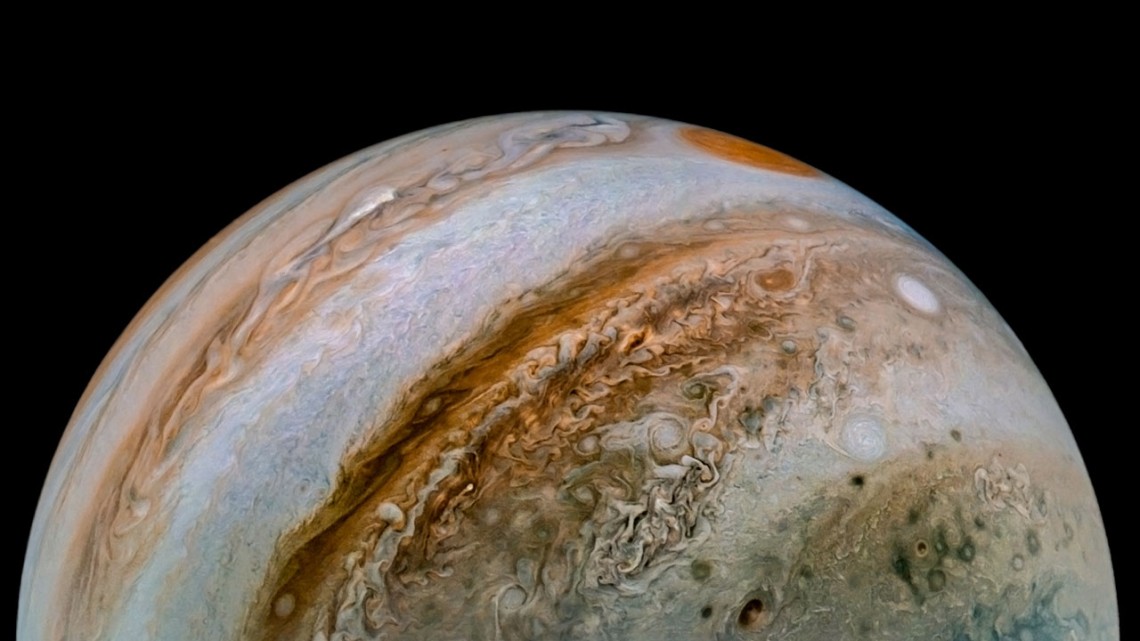
An image of Jupiter's Great Red Spot, upper right, and the planet's swirling surface, was taken by the Juno spacecraft on Dec. 30, 2020.
Juno craft provides first 3D view of Jupiter’s deep storms
By Blaine Friedlander
After gazing at Jupiter’s Great Red Spot and the planet’s gaseous cloudy realm, NASA’s Juno spacecraft and its microwave radiometer have provided humanity’s first 3D, turbulent sense of what lies far below its swirling surface.
The work, reported by a dozen international scientists, including Cornell’s Jonathan Lunine, appears in the Oct. 28 journal Science.
“Jupiter’s storms run deep,” said Lunine, the David C. Duncan Professor in the Physical Sciences and chair of the Department of Astronomy, in the College of Arts and Sciences. “This answers questions that scientists have asked for 200 years and science has made detailed observations of this distant planet for more than a century. Do these storms painted on Jupiter’s surface go deep down? Yes, the storms go deep – not to Jupiter’s core – but at least a couple of hundred miles below the top cloud layer.
“In effect,” Lunine said, “Juno has given us pictures of Jupiter’s storms with depth.”
NASA launched the Juno spacecraft to study Jupiter in August 2011, arriving in July 2016, and after five years of exploration, NASA has extended its time at Jupiter for four more years.
“Previously, Juno surprised us with hints that phenomena in Jupiter’s atmosphere went deeper than expected,” said lead author Scott Bolton, a space physicist at the Southwest Research Institute in San Antonio, Texas, and the spacecraft’s principal investigator. “Now, we’re starting to put all these individual pieces together and getting our first real understanding of how Jupiter’s beautiful and violent atmosphere works – in 3D.”
The spacecraft’s microwave radiometer examined three major regions of Jupiter: the iconic Great Red Spot in the planet’s Southern Hemisphere, a centuries-old anticyclonic vortex; a smaller anticyclonic vortex at latitude 19 degrees North; and a cyclonic storm at latitude 38 degrees North.
Lunine explained that the planet’s Great Red Spot spins counterclockwise and so is a high-pressure system – twice the width of Earth. The barge-like storm at 38 degrees North is like those on Earth in that it is a low-pressure system that may produce a lot of ammonia and water rain, while the feature at 19 degrees North spins clockwise, much like a high-pressure fair-weather system on Earth.
The findings indicate that the vertical extent of these storms was far greater than expected. The Great Red Spot, for example, extended to more than 200 miles below its reddish cloud top, with the other features somewhat shallower.
By observing the storms in depth and 3D, the scientists are working out how Jupiter’s atmospheric convection works. For example, the scientists now can see how large hail – made of ammonia and water, nicknamed “mushballs” – build up in storm clouds in Jupiter’s giant atmosphere. As the ammonia mushballs get heavier, they fall out of the clouds, much like hail on Earth.
While hail hits the ground on Earth, the mushballs continue to fall and slowly vaporize, as they have no ground to hit.
Lunine’s funding in this research, “Microwave Observations Constrain the Depth of Vortices in Jupiter’s Atmosphere,” was provided by the Juno Project through the Southwest Research Institute.
Media Contact
Get Cornell news delivered right to your inbox.
Subscribe
